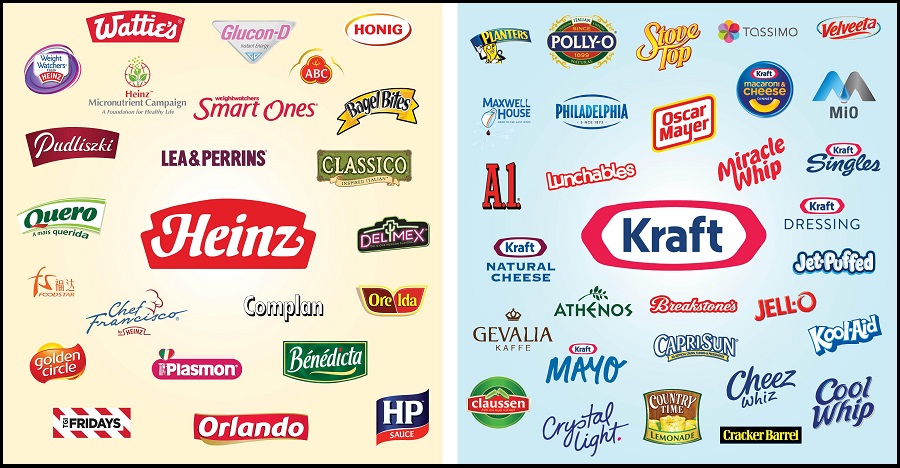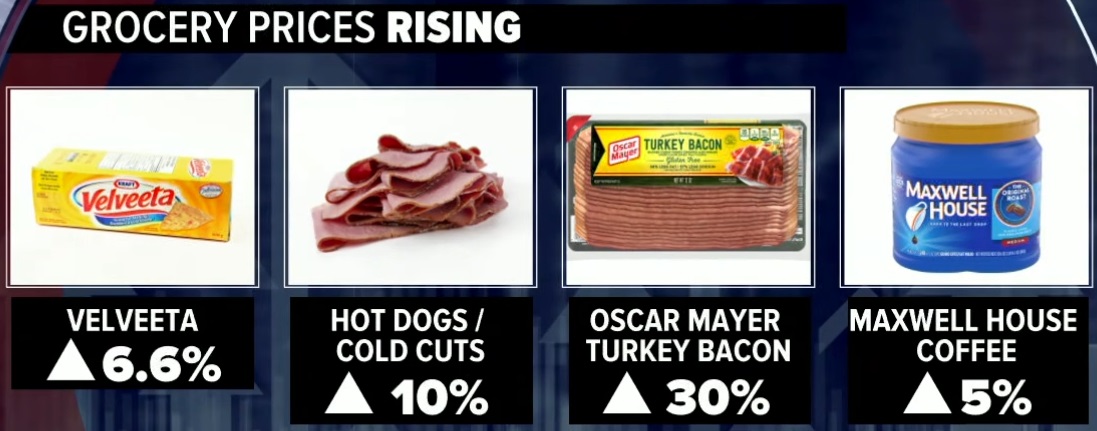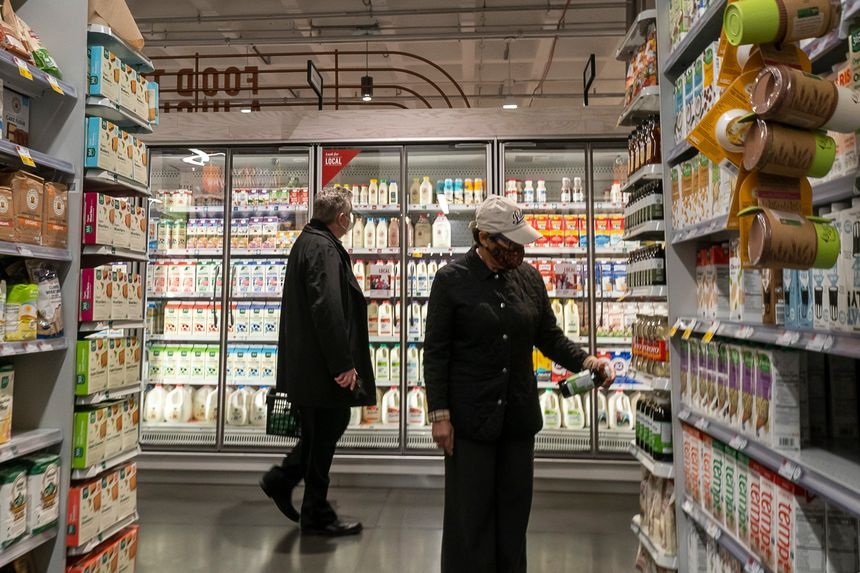Kraft-Heinz has announced the next wave of anticipated inflationary prices for their products. The announcement, and the timeline they provide for the price increases, is exactly in line with our prior estimations.
Prior CTH outlines on the path of inflation for this specific company are HERE (Dec) and HERE (Jan). Keep in mind, depending on the size of the buyer or wholesaler, and depending on the terms of the contracts for purchase, generally speaking, terms are net payment in 30, 60 or 90 days based on 180 day contracted price agreements which include rebates to retailers.

(Reuters) […] “The company expects inflation to be in the low-teens percentage range for 2022, with higher levels in the first half than in the second, said Chief Financial Officer Paulo Basilio.” (link)
Both Proctor & Gamble and Kraft-Heinz provide the best data points to predict future retail grocery inflation. Based on their previous notifications, we can now see that Kraft is anticipating the March – July rates of increase to remain approximately where they have been (20 to 30%) and then stabilize in the last half of the year bringing the yearly average into the “low teens.” This timeline is what we predicted back in October.
The prices we will see at the grocery stores will rise again in the spring (this is the backside of the inflationary cycle), continue through mid-summer, and then price increases should likely level off at the end of summer this year. Between the price today and the price at the point of leveling is approximately a 20% increase.
Each segment is different. However, on average a $5 item now will cost around $6 mid-summer, then settle. Average food basket prices going into the July 4th holiday will be approximately 20% higher than current, and 40% higher than July 2021. Some items will be 50 to 60% higher July 4, 2022, versus July 4, 2021.
 Dairy products into manufacturing and processing went up 4.5% last month alone. Those price increases will continue accumulating into the products as ingredients. Expect another +25% on dairy goods at retail. Plastic packaging (jugs etc) is part of that product price.
Dairy products into manufacturing and processing went up 4.5% last month alone. Those price increases will continue accumulating into the products as ingredients. Expect another +25% on dairy goods at retail. Plastic packaging (jugs etc) is part of that product price.
Household chemicals, cleaning products, laundry detergents, paper goods as well as health and beauty care products like soaps, shampoos, dental and cosmetics, will see much higher price increases than food products because the raw materials (bases and chemicals) are off the charts higher in price. Cleaning products at wholesale jumped 3.8% in January alone. Expect to see anything containing chemicals on the extreme high end of price increases this year.
Another serious issue are paper and cardboard prices which are likely going to jump another 30 to 50% before they stop (if they do). Everything above comes shipped in boxes, so the cost of products carries the increased cost of the shipping cardboard.
Keep in mind a few points:
(1) The outlined price increases noted are against current price terms and contracts. Meaning, these are price increases from right now to the next fulfillment. These are not inflation price increases which are compared to a year ago. These are 5% to 20% increases from the current price right now.
(2) The price increases are not the final price increase. This is the price of a contract today from the field to the distribution center. The retailer also has additional price increases (transportation, energy, labor, etc) which they need to add to the wholesale price before you see the final price at retail (grocery store).
The final field to fork price is not yet known but will be higher than noted above. We are only seeing the notifications from field, through processing (Kraft and P&G) and into warehousing and distribution.
 Additionally, the more an item needs to be processed, the higher the price increase will be. Food items that require multiple raw materials, ingredients and bases for processing (ex. condiments), when combined with increased packaging costs (oil, energy), will be much higher than foods with less processing, handling and packaging.
Additionally, the more an item needs to be processed, the higher the price increase will be. Food items that require multiple raw materials, ingredients and bases for processing (ex. condiments), when combined with increased packaging costs (oil, energy), will be much higher than foods with less processing, handling and packaging.
This has always been the nature of this specific supply chain.
Example: Many products, food, drinks and even cleaning products, contain citrus bases, additives, flavorings and distillation. Those products will be much higher in price due to the price increases in raw materials, combined with higher energy and petroleum costs. It is an issue of cumulative price increases in the production of the product from beginning to end.
Unfortunately, pet foods, specifically wet pet foods, will also be on the higher end of the price increases. Pet foods are subject to the higher end of price increases due to manufacturing and processing. Many high-end wet pet foods are also imported, so the transportation costs are higher.
CTH has recommended preparing for these massive increases in 2022 prices by thinking about the base products you use to make meals at home and holding an extra supply of shelf stable products, so you won’t hit the grocery store and face those massive increases. Another example will be coffee. Keep in mind Kraft Foods is Maxwell House, and coffee requires roasting (another energy cost).
The $200 food basket in early 2021 is now around $275. That same food basket will likely reach $325 this summer. I wish there were a better way to put it, because at the end of these price jumps is a lot of hardship for many working families.
Believe me, I feel that pain. I know what it looks like to see a grocery bill at checkout that suddenly makes the monthly car, rent or mortgage payment more challenging. That’s why we have been trying to support everyone with fact-based expectations since last fall, so we could help readers prepare ourselves to support our families, kids and grandkids who might be seeing these issues for the first time in their lives.
On the durable goods side of the equation, other than energy-price-impacted goods (tires, oils, rubber components etc), we can expect to see price increases of durable goods (electronics etc) settle down much faster this year, likely before spring. Unfortunately, the reason is obvious as demand is continuing to drop.
We must get the Democrat Communists out of office and stop the assault on the energy industry before it’s too late. If we do not get rid of them, we will lose the middle class.
Let’s Go Brandon!

You mean to tell me the 25% EBT foodstamp increase was a big money launder operation to John Kerry and Warren Buffet?
Come on Joe Stalin wouldn’t do that…. LOL. He’s always on the Up and Up.
Biden – Let me Whip Out My “Farm Bill”.
Woke Yet?
Thoughts inside the Progressives Hive Mind realizing that Groceries cost more due to Let’s Go Brandon:
“At least he’s not making mean tweets!”
Another . . . . “The President doesn’t control food prices.”
Congress will be voting themselves and their millions of helpers a fat pay raise. After all they do to us, they deserve it. Well we can’t stop them anyway.
They already skate on paying capital gains tax on their insider trading and fraudulent real estate and money laundering operations.
Why would they need a pay raise
That they will.
After all, they exempted themselves from OBummaCare & the Jab!
Those who can’t see this tyranny are obviously involved in it, somehow.
NY Post – 4 days ago
Chicken producers warn of fast spreading bird flu across US
Picked up groceries today. $60 for me and $60 in dog food for Baby El and his brother.
No frozen potatos and lunch meat was running $8/lb for what little they had.
Bought a pack of hot dogs and a large can of beans. I’ll make a loaf of bread tomorrow, so I’m good for about 3 days right there. Last week was 4 days of split pea soup.
I grew up in the ’70s. If your going to make me suffer, you’ll have to try a lot harder.
same here, we made do in the 70’s,,,,remember odd/even gas days?
All too well. The food was so bad I was anemic as a child. I remember my neighbor kid having macaroni and canned milk for lunch and wishing I could have some, but not daring to ask.
Good times.
Yep, and gas quickly doubling in price too. I also got hit in the food department, I remember this concoction called slumgullion
heck I don’t know how it was spelled but it was a watery tomato sauce with a bit of hamburger, shell macaroni and green beans in it.
Dinner in one dish. Watching Watergate on the TV. Epic times. Just like now, heh.
I was in college in the 70’s (scholarship) and my daily food budget out of my work-study job was $7. I lived mostly on cereal, one tunafish sandwich a day, and sometimes some ice cream.
You must have been paying full price, because $7 a day is over $200 a month. That is my current food budget for 2 adults and we are eating pretty well on that. I use every single tactic I can to save money on groceries while eating well.
My fave cheap but filling dish is “bacon fat bread”. Mind you, Kroger bacon in my NE NC area is around $5.49/lb and I usually get in the mail a $1.40 coupon monthly for the bacon, bringing it down to $4.10/lb. Far far less than Oscar Meyer. We fry the bacon, and then fry bread in the bacon grease. I’m sure it is hell on the arteries, but man oh man is it tasty and filling! I have a recipe for the tomato sauce/burger/pasta optional, and green beans called Castellian Skillet. Very good, filling, and low carb to boot.
I was a wee small child but yep I do recall those days.
Grew up in the 40’s.
My favorite meal was the “Fisher-Girl” sandwich I was told would make me a strong fisher-girl on the North Sea.
It was mashed potatoes on bread.
Rest of family still in Scotland were the bad off ones.
Nothing surprises me.
Smoked ham hocks add great flavor to split pea soup. If not available, add hot dogs like my mother did when I was a kid in the 1960s.
For whatever reason, ham hocks have been hard to come by here (outside of Knoxville, TN) ever since the pandemic started in 2020. I buy half a ham from Costco and we freeze part of it and use the bone for lentils and bean soups. I try not to waste. I save all our chicken bones from meals and keep in the freezer until I have enough to fill the instant pot. I make bone broth (add a little bit of white vinegar to draw out the calcium) by cooking about 3 hours and then straining and defatting. Most of the chickens I buy are whole because one of the grocery stores has been selling Tyson’s for $.99/lb. When I cut into pieces I set the back aside for the broth. When I bake whole chickens, I also put the carcass remains in for the broth. No waste–healthy and tasty broth for base for soups, etc., dogs get to eat any meat still left after I remove from bones and then bones discarded. A $5 chicken can go a long way.
Dollar General sells 1 lb.canned hams for $3.25. A cheap, tasty and shelf stable protein source.
LOL, great comment, I guess that’s because I can relate! 😅
Love split pea soup. I make it in a crockpot, and I use smoked turkey breast in chunks instead of ham – taste is very similar but not as fatty. Also plenty of garlic/onion, marjoram, thyme, and a little curry.
In fact it’s probably time for a new batch of that. Thanks for the idea.
I read on my Food Shortage Alerts group that while packaged lunch meat is running $8/lb, the deli equivalent is far less, and also fresher in many places. Something to consider.
My frugal strategy is to buy meat on sale, cook it, and then use slices of that for sandwiches. I seldom buy lunch meat, but often have chicken, turkey and beef sandwiches. Much cheaper, but more work.
I have a freezer full of 49 cents a pound turkey, $1 a pound chicken and $2 a pound beef. The only one that has gone up lately is beef. The last time I saw $2 a pound was Labor Day unless it was on short dated sale.
More to boycott kraft brand.
Yep, and thanks for the “don’t buy” list…
Don’t worry. The Dems are totally on top of this:
https://citizenfreepress.com/breaking/madame-speaker-tries-to-sell-inflation-as-a-good-thing/
“price increases should likely level off at the end of summer this year”
That’s optimistic.
This year’s crop will be reduced and more expensive due to fertilizer and weed treatment costs and shortages.
If prices do level off this summer, it will just be in preparation for next year’s launch.
In time for midterms…
Remember the massive list of companies not to buy from ?
Everyone needs to do without their products like their lives depend on it because it does.
Your $$$$$ are powerful if we stop buying their garbage
shop small, shop farmer, shop very local, try to grow a lot, try to store a lot,,,,we have a grocery in our basement
Joe playing teacher, again
It grates on me to no end that this man HAS NEVER HAD A REAL JOB, never made a payroll, never worked 80-hour work weeks while not taking much of a salary, so he can pay his people….
He’s lived off of us his whole life, and even then, it’s been just peanuts to him, because the big deals are in the selling of his influence, through his addict bagman son.
I guess he thinks that we can just go and get bribes like him, to supplement our eroding paychecks.
If you ever decide to move on from store brand condiments, one of my favorites is Todd Wilber.
He’s a ‘reverse-engineer’ chef that has several books on making knock-off versions of favorite condiments and main dishes.
For anyone interested: https://topsecretrecipes.com/Todd-Wilbur-Top-Secret-Recipe-Books
disclaimer: I am in no way affiliated with this guy other than as a fan. Just sharing favorite bunker recipe resources for when we have to go in. No point in eating Ramen everyday if you don’t have to.
HFCS – high fructose corn syrup , its in almost everything ( made by ADM )
Silicon dioxide – that stuff in the moisture absorber packets that say DO NOT EAT , used in food as anti-caking agent , FDA says ok if less than 2 % volume of the product.
MSG – has many ‘ names ‘ , torula yeast and/or hydrolized vegetable protein ?
I Read the book – WHATS IN YOUR FOOD , years ago.
PS dont even ask about ” mechanically seperated ” meat products.
Every time I drove past the rendering plant and saw the dead drop calves and dairy cows pushed into a pile against
the gate, mechanically separated came to mind 🙂
I was at my local GE grocery store the other day and people were walking around like zombies. They seem to be in total shock at the prices, the reduced product amount.
My grocery store is trying their best to disguise the less products on the shelves, by moving stuff around and widening the isles, bringing in the walls, and removing check out lanes. It really is astonishing.
Most people had very few items in their carts.
What has been interesting to me is the amount of people now shopping during the day. It was never like that before.
saw the same thing today – wondered where all the people came from as I usually try for a time with few shoppers.
Lots of “slow shoppers” as I call em. Totally paralyzed by the prices, but still needing to buy food. Some things I just couldn’t compel myself to buy due to the price shock (breaded chicken for instance).
I luckily got the last package of boneless ribeyes at my NE NC Food Lion today. Valentines day special $7.99/lb. Those bad boys will be put back and savored, in time……
What’s your general location, mal and baby el?
Thanks for the heads up, Mr. Heinz. I’ll make sure to avoid all of these products, which are mostly crap anyway.
It’s going to get much worse.
I don’t mean to black pill anyone but..it’s done.
I learned this from The Expanse. When Ganymede station was destroyed. This is an example of cascade failure.
Global economy is a simple complex system. It’s complex because their are many inputs. However unlike a natural ecosystem or economy, it’s simple.
In a natural ecosystem or economy fails in certain pathways, there are many other things that can take up the slack.
Globalism is an artificial economy.
In an artificial system, there are only so many pathways. When one fails it puts stress on the others.
So then another pathway (certain raw materials) gets stressed and they fail.
Then the next pathway fails.
Paper shortage? It’s not just boxes. Ramen noodles, TV dinners, frozen fish. How much of your food is packed in Paper? Or plastic? Oil isn’t just for gasoline and plastic. It’s for fertilizer and pesticides.
I know zman predicted this at least a year ago.
Stock up and hunker down. The system has collapsed and there is no fixing it.
As it was said by the plant guy. This station is dead, they just don’t know it yet.
Heinz is married to John Kerry now!
Looks like John Kerry can afford a new yacht this spring.
You should see Putins.
Left the German repair docks in a hurry last week before it could get seized.
Almost forgot……
At the grocery store today, in the middle of the empty pasta shelf was a piece of unfolded construction paper, neatly stood on edge.
Written in big sharpie were the letters F J B.
Well, duh, the solution is obvious. Price controls. Let the fun begin. The psychopaths want to turn this country into one big third world craphole.
Fair elections are a thing of the past. Just a matter of time until the sickos hit rock bottom.
In a few days, price of avocados will skyrocket and then the supply may be cut entirely.
https://legalinsurrection.com/2022/02/avocado-crisis-looms-as-prices-escalate-and-supply-from-mexico-may-be-cut/
California grows avocados.
But yes, they will get very expensive, no doubt.
I had this new shortage in mind when I bought a bunch of bright green ones today. I keep them out on the counter for exactly 5 days, and then store in frig in a basket (no plastic).
I hear a case went from $50 to $200.
Check it out:
The Dem Talking Point “it’s not .govs fault, it’s the Businesses”, is being discussed on Cspan tonite.
…………”Hearing on Pandemic Price Gouging
11:03 PM ON CSPAN3 105
The House Energy & Commerce Subcommittee on Consumer Protection and Commerce holds a hearing on corporate price gouging during the COVID-19 pandemic.”………..
Prices level out just before elections. Hey, look we have defeated inflation. We will still be paying 40% more and prices won’t go back down, but the BSN (Bull Sh!t News) will report and 40% will lap it up like honey.
https://www.zerohedge.com/commodities/rabobank-warns-coffee-prices-may-soar-out-control-stockpiles-plunge
Coffee going up even more
I don’t even drink coffee and have 20 cans in storage. They were sales a couple of months ago and I know people who live on coffee. I’m thinking it was a good $20 investment in friends.
Regarding household cleaning products, baking soda and/or hydrogen peroxide are quite effective cleaners. They are non-toxic and don’t give off toxic fumes. They can be used separately or combined into a paste to clean most household surfaces.
Warm, soapy water with some white vinegar added is great for cleaning greasy surfaces. The acid in the vinegar cuts through the grease.
All of the above-mentioned ingredients are much cheaper (and better for our health) than the chemical cleaners the big corporations want us to buy and use.
Castile soap and very hot water work really well too! We use Dr. Bronner’s brand. It cuts grease on frying pans, makes a great foaming hand soap, and I make an all-purpose cleaning spray for surfaces (1 Tbs. borax, 2 cups hot water, shake well to dissolve borax, 2 Tbs. vinegar, 2 Tbs. Castile soap, swirl gently to mix).
The higher the inflationary price increases, the greater the anger of the populace will be against the incumbent regime.
Need to throw these fascist leftists out of power in the House and Senate. Then in 2024 the WH too.
But never underestimate the stupidity of the voters to believe the propaganda lies they are fed.
Hey, I can make mayo, ketsup and Mac&cheez in a blue box, only better, so …
boycott!! boycott!! boycott kerry and his wife teresa
What wonderful news for John Kerry – more big private jets & mansions!
But more hodgepodge leftovers for average Americans at mealtime.
I went to Albertson’s today (a SoCal grocery chain).
Wanted to buy some fish patties to make a surf and turf sandwich…. THEY WERE OUT…. I spoke with the meat counter and the fellow told me they’ve been out for two weeks… He keeps ordering but he only gets a little bit every so often.
I spoke with cashier about it and he told me they’re also out of cream cheese and spaghetti.
WTF? Not just ONE brand, mind you, but the entire product. And, I noticed too that the standard size of Campbell’s Chicken Noodle soup is still out.
This feels like a Soviet place where we buy what they got, not what we want.
BRING BACK TRUMP.
John Kerry needs this to pay for his private jet fuel.